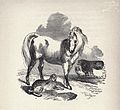
Fable is a literary genre defined as a succinct fictional story, in prose or verse, that features animals, legendary creatures, plants, inanimate objects, or forces of nature that are anthropomorphized, and that illustrates or leads to a particular moral lesson, which may at the end be added explicitly as a concise maxim or saying.

William Cowper was an English poet and Anglican hymnwriter.

Thomas Bewick was an English wood-engraver and natural history author. Early in his career he took on all kinds of work such as engraving cutlery, making the wood blocks for advertisements, and illustrating children's books. He gradually turned to illustrating, writing and publishing his own books, gaining an adult audience for the fine illustrations in A History of Quadrupeds.

William Somervile or Somerville was an English poet who wrote in many genres and is especially remembered for "The Chace", in which he pioneered an early English georgic.

Aesop's Fables, or the Aesopica, is a collection of fables credited to Aesop, a slave and storyteller who lived in ancient Greece between 620 and 564 BCE. Of varied and unclear origins, the stories associated with his name have descended to modern times through a number of sources and continue to be reinterpreted in different verbal registers and in popular as well as artistic media.
The story and metaphor of The Dog in the Manger derives from an old Greek fable which has been transmitted in several different versions. Interpreted variously over the centuries, the metaphor is now used to speak of one who spitefully prevents others from having something for which one has no use. Although the story was ascribed to Aesop's Fables in the 15th century, there is no ancient source that does so.
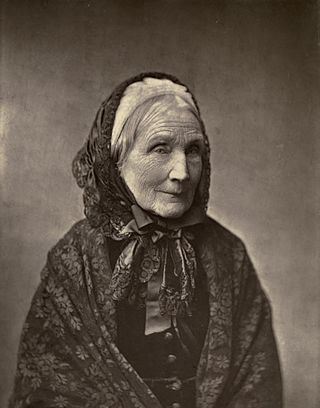
Mary Howitt was an English poet, the author of the famous poem The Spider and the Fly. She translated several tales by Hans Christian Andersen. Some of her works were written in conjunction with her husband, William Howitt. Many, in verse and prose, were intended for young people.

Samuel Howitt (1756/57–1822) was an English painter, illustrator and etcher of animals, hunting, horse-racing and landscape scenes. He worked in both oils and watercolors.
The Crow or Raven and the Snake or Serpent is one of Aesop's Fables and numbered 128 in the Perry Index. Alternative Greek versions exist and two of these were adopted during the European Renaissance. The fable is not to be confused with the story of this title in the Panchatantra, which is completely different.

The Elm and the Vine were associated particularly by Latin authors. Because pruned elm trees acted as vine supports, this was taken as a symbol of marriage and imagery connected with their pairing also became common in Renaissance literature. Various fables were created out of their association in both Classical and later times. Although Aesop was not credited with these formerly, later fables hint at his authorship.
The Fox and the Woodman is a cautionary story against hypocrisy included among Aesop's Fables and is numbered 22 in the Perry Index. Although the same basic plot recurs, different versions have included a variety of participants.

A History of British Birds is a natural history book by Thomas Bewick, published in two volumes. Volume 1, Land Birds, appeared in 1797. Volume 2, Water Birds, appeared in 1804. A supplement was published in 1821. The text in Land Birds was written by Ralph Beilby, while Bewick took over the text for the second volume. The book is admired mainly for the beauty and clarity of Bewick's wood-engravings, which are widely considered his finest work, and among the finest in that medium.

The Ape and the Fox is a fable credited to Aesop and is numbered 81 in the Perry Index. However, the story goes back before Aesop's time and an alternative variant may even be of Asian origin.
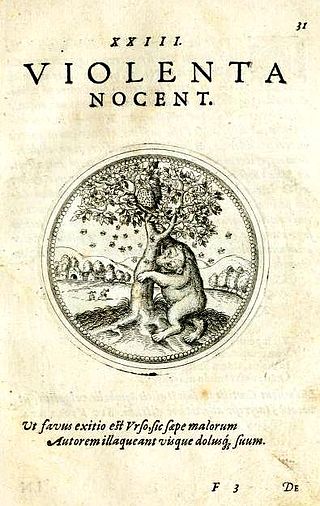
The Bear and the Bees is a fable of North Italian origin that became popular in other countries between the 16th - 19th centuries. There it has often been ascribed to Aesop's fables, although there is no evidence for this and it does not appear in the Perry Index. Various versions have been given different interpretations over time and artistic representations have been common.
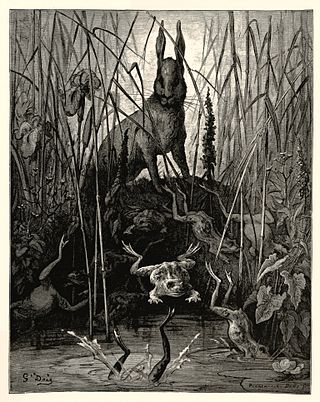
Hares are proverbially timid and a number of fables have been based on this behaviour. The best known, often titled "The Hares and the Frogs", appears among Aesop's Fables and is numbered 138 in the Perry Index. As well as having an Asian analogue, there have been variant versions over the centuries.
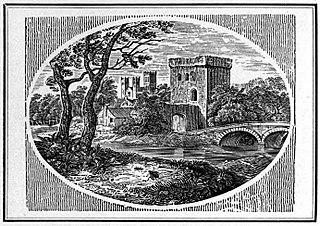
The Fly and the Ant is one of Aesop's Fables that appears in the form of a debate between the two insects. It is numbered 521 in the Perry Index.

The story of the bald man and the fly is found in the earliest collection of Aesop's Fables and is numbered 525 in the Perry Index. Although it deals with the theme of just punishment, some later interpreters have used it as a counsel of restraint.

The bulls and the lion is counted as one of Aesop's Fables and is numbered 372 in the Perry Index. Originally it illustrated the theme of friendship, which was later extended to cover political relations as well.
The Frog and the Fox is one of Aesop's Fables and is numbered 289 in the Perry Index. It takes the form of a humorous anecdote told against quack doctors.

Ernest Henri Griset was a French-born painter and illustrator noted for the humorous interpretations of his subjects. He specialized especially in animal illustrations many of which were made for children's books as well as magazines like Punch.





